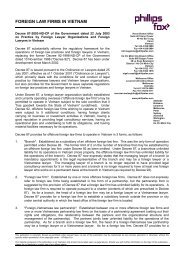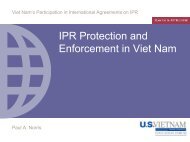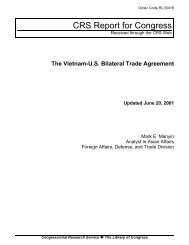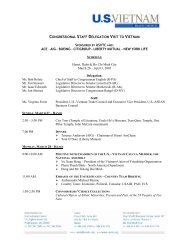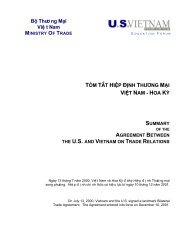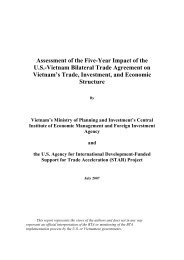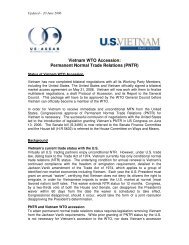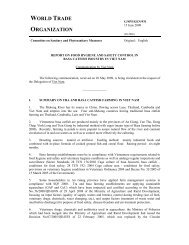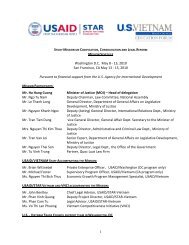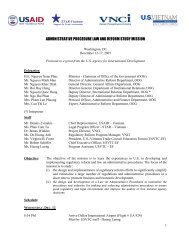Climate risks and adaptation in Asian coastal megacities: A synthesis
Climate risks and adaptation in Asian coastal megacities: A synthesis
Climate risks and adaptation in Asian coastal megacities: A synthesis
- No tags were found...
You also want an ePaper? Increase the reach of your titles
YUMPU automatically turns print PDFs into web optimized ePapers that Google loves.
is also a key economic <strong>and</strong> f<strong>in</strong>ancial center <strong>and</strong> acore part of the Southern Economic Focal region <strong>in</strong>Vietnam. The city’s official population is estimatedto be about 6.4 million people. The actual currentpopulation, which <strong>in</strong>cludes temporary <strong>and</strong> unregisteredmigrants, is estimated to be 7–8 million. Thepopulation of HCMC has been grow<strong>in</strong>g at a rateof 2.4 percent per year, which is a faster rate thananywhere else <strong>in</strong> the country. The city accounted forover 23 percent of the country’s GDP <strong>in</strong> 2006 (ADB2010). Rapid economic growth—11.3 percent annuallybetween 2000 <strong>and</strong> 2007—has been the centraldriver beh<strong>in</strong>d the city’s expansion, as the <strong>in</strong>creas<strong>in</strong>gnumber <strong>and</strong> magnitude of <strong>in</strong>come earn<strong>in</strong>g opportunitiesattract migrants from throughout Vietnam.Key economic growth sectors <strong>in</strong>clude <strong>in</strong>dustrial<strong>and</strong> service sectors, which have grown at a rate of11.9 percent <strong>and</strong> 11.1 percent annually respectivelyTable 3.10 ■ HCMC District PovertyRates, 2003Urban districtsRural districtsPoverty RatePoverty RateDistrict(%) District(%)District 1 2.4 Cu Chi 6.9District 2 4.5 Hoc Mon 6.9District 3 2.8 B<strong>in</strong>h Chanh 4.4District 4 5.6 Nha Be 12.9District 5 3.8 Can Gio 23.4District 6 5.5District 7 3.0District 8 7.4District 9 5.0District 10 3.0District 11 4.6District 12 6.3Go Vap 6.9Tan B<strong>in</strong>h 5.5B<strong>in</strong>h Thanh 5.0Phu Nhuan 3.7Thu Duc 7.8HCMC average poverty rate 5.4Source: Inter-m<strong>in</strong>isterial Poverty Mapp<strong>in</strong>g Task Force, 2003, cited <strong>in</strong> ADB (2010).between 2000 <strong>and</strong> 2007. Dur<strong>in</strong>g the same period, agriculture<strong>and</strong> related activities have grown relativelyslowly at a rate of 4.8 percent annually (ADB 2010).Nature of poverty <strong>in</strong> HCMCIn 2006, HCMC had an overall poverty rate of 0.5percent (GSO Vietnam 2006). 38 While this rate is thelowest <strong>in</strong> the country, the absolute number of poor<strong>in</strong> the city is still high at between 30,000 <strong>and</strong> 40,000persons. In addition, the number of households liv<strong>in</strong>g<strong>in</strong> <strong>in</strong>adequate hous<strong>in</strong>g <strong>and</strong> poor environmentalconditions is likely to be much higher than the officialpoverty rate suggests. If unregistered migrantsare primarily poor, then the poverty rate would alsobe higher due to the large numbers of migrants miss<strong>in</strong>gfrom official statistics. Spatially disaggregateddata for the city shows that there is significant variation<strong>in</strong> poverty levels <strong>in</strong> different parts of HCMC.In general, rural districts have higher poverty levelscompared to more urban districts. The highest povertylevels are <strong>in</strong> the relatively sparsely populatedrural districts of Can Gio <strong>and</strong> Nha Be to the southof the city toward the coast. These are also the twodistricts that are the most prone to flood<strong>in</strong>g <strong>in</strong> thecity (Table 3.10).<strong>Climate</strong> <strong>and</strong> precipitation <strong>in</strong> the Dong NaiRiver Bas<strong>in</strong>HCMC has a tropical monsoon climate with pronouncedwet <strong>and</strong> dry season variations <strong>in</strong> precipitation.There is a large variation <strong>in</strong> monthly precipitation,but relatively constant daily temperatures withan annual average <strong>in</strong> the range of 26–27 o C <strong>and</strong> avariation between months <strong>in</strong> the range of 4° to 5 o C.As shown <strong>in</strong> Table 3.11, precipitation is highest <strong>in</strong>the months from May to November, account<strong>in</strong>g for90 percent of the annual ra<strong>in</strong>fall. Typhoon eventscan pass over HCMC. The dry season runs fromDecember to April <strong>and</strong> can cause drought conditionsregularly. Extreme droughts have occurred <strong>in</strong>1993, 1998, <strong>and</strong> 2002.38This is calculated on the basis of the expenditure typicallyrequired to meet a m<strong>in</strong>imum daily calorific requirementof 1,700 Kcals. A number of qualifications need to be made,as the official figure does not <strong>in</strong>clude migrants.Estimat<strong>in</strong>g Flood Impacts <strong>and</strong> Vulnerabilities <strong>in</strong> Coastal Cities | 39



